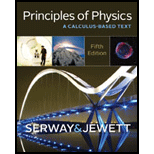
(a)
The energy of the particle in terms of
(a)
Answer to Problem 55P
The energy of the particle in terms of
Explanation of Solution
Write the Schrodinger’s equation.
Here,
Write the equation for the potential energy.
Here,
Write the expression of the given wavefunction.
Take the derivative of the above wave function with respect to
Take the derivative of the above equation with respect to
Put equations (II), (III) and (IV) in equation (I) and rearrange it.
Equation (V) will be true for all
Write the equation for the reduced Planck’s constant.
Here,
Conclusion:
Put equation (VII) in (VI).
Therefore, the energy of the particle in terms of
(b)
The normalization constant
(b)
Answer to Problem 55P
The normalization constant
Explanation of Solution
The given wavefunction is an even wavefunction.
Write the normalization condition for the given even wave function.
Put equation (III) in equation (VIII) and rearrange it.
Integrate the above equation.
Rearrange the above equation for
Conclusion:
Therefore, the normalization constant
(c)
The probability that the particle is located in the range
(c)
Answer to Problem 55P
The probability that the particle is located in the range
Explanation of Solution
Write the equation for the probability that the particle lies in the range
Here,
Put equation (III) in equation (IX) and rearrange it.
Integrate the above equation.
Conclusion:
Substitute
Therefore, the probability that the particle is located in the range
Want to see more full solutions like this?
Chapter 28 Solutions
Principles of Physics
- Suppose a wave function is discontinuous at some point. Can this function represent a quantum state of some physical particle? Why? Why not?arrow_forwardA particle of mass m is confined to a box of width L. If the particle is in the first excited state, what are the probabilities of finding the particle in a region of width0.020 L around the given point x: (a) x=0.25L; (b) x=040L; (c) 0.75L and (d) x=0.90L.arrow_forwardA quantum particle is described by the wave function ψ(x) = A cos (2πx/L) for −L/4 ≤ x ≤ L/4 and ψ(x) everywhere else. Determine:arrow_forward
- The first four Hermite polynomials of the quantum oscillator areH0 = 1, H1 = 2x, H2 = 4x2 − 2, H3 = 8x3 − 12x. Let p(x) = 12x3 − 8x2 − 12x + 7. Using the basis H = {H0, H1, H2, H3}, find the coordinate vector ofp relative to H. That is, find [p]H. This is a textbook question, not a graded questionarrow_forwardIf the ground state energy of a simple harmonic oscillator is 1.25 eV, what is the frequency of its motion?arrow_forward
 Principles of Physics: A Calculus-Based TextPhysicsISBN:9781133104261Author:Raymond A. Serway, John W. JewettPublisher:Cengage Learning
Principles of Physics: A Calculus-Based TextPhysicsISBN:9781133104261Author:Raymond A. Serway, John W. JewettPublisher:Cengage Learning Physics for Scientists and Engineers with Modern ...PhysicsISBN:9781337553292Author:Raymond A. Serway, John W. JewettPublisher:Cengage Learning
Physics for Scientists and Engineers with Modern ...PhysicsISBN:9781337553292Author:Raymond A. Serway, John W. JewettPublisher:Cengage Learning Modern PhysicsPhysicsISBN:9781111794378Author:Raymond A. Serway, Clement J. Moses, Curt A. MoyerPublisher:Cengage Learning
Modern PhysicsPhysicsISBN:9781111794378Author:Raymond A. Serway, Clement J. Moses, Curt A. MoyerPublisher:Cengage Learning University Physics Volume 3PhysicsISBN:9781938168185Author:William Moebs, Jeff SannyPublisher:OpenStax
University Physics Volume 3PhysicsISBN:9781938168185Author:William Moebs, Jeff SannyPublisher:OpenStax Physics for Scientists and Engineers: Foundations...PhysicsISBN:9781133939146Author:Katz, Debora M.Publisher:Cengage Learning
Physics for Scientists and Engineers: Foundations...PhysicsISBN:9781133939146Author:Katz, Debora M.Publisher:Cengage Learning




